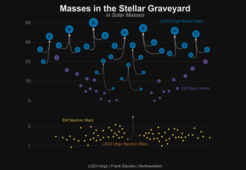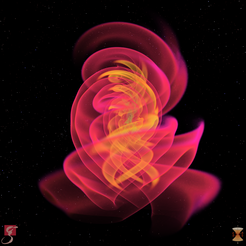LIGO and Virgo announce four new gravitational-wave detections
The observatories are also releasing their first catalog of gravitational-wave events
During the first observing run O1, from September 12, 2015 to January 19, 2016, gravitational waves from three BBH mergers were detected. The second observing run, which lasted from November 30, 2016, to August 25, 2017, yielded a binary neutron star merger and seven additional binary black hole mergers, including the four new gravitational wave events being reported now. The new events are known as GW170729, GW170809, GW170818 and GW170823 based on the dates on which they were detected. With the detection of four additional BBH mergers the scientists learn more about the population of these binary systems in the universe and about the event rate for these types of coalescences.
The observed BBHs span a wide range of component masses, from 7.6 to 50.6 solar masses. The new event GW170729 is the most massive and distant gravitational-wave source ever observed. In this coalescence, which happened roughly 5 billion years ago, an equivalent energy of almost five solar masses was converted into gravitational radiation.

In two BBHs (GW151226 and GW170729) it is very likely that at least one of the merging black holes is spinning. One of the new events, GW170818, detected by the LIGO and Virgo observatories, was very precisely pinpointed in the sky. It is the best localized BBH to date: its position has been identified with a precision of 39 square degrees (195 times the apparent size of the full moon) in the northern celestial hemisphere.
Table 1: In total, ten binary black hole mergers and one binary neutron star merger have been confidently detected to date. The detections that are reported for the first time are marked in blue. Mf is the mass of the final black hole formed after merger. The mass missing from the sum of the component black holes was converted into gravitational waves.
The scientific papers describing these new findings present a catalog of all the gravitational wave detections and candidate events of the two observing runs as well as describing the characteristics of the merging black hole population. Most notably, the scientists find that almost all black holes formed from stars are lighter than 45 times the mass of the Sun.
“State-of-the-art waveform models, advanced data processing and better calibration of the instruments, have allowed us to infer astrophysical parameters of previously announced events more accurately”, says Alessandra Buonanno, director of the “Astrophysical and Cosmological Relativity” division at AEI-Potsdam, and College Park professor at University of Maryland. “I look forward to the next observing run in Spring 2019, where we expect to detect more than two black-hole mergers per month of collected data!”
“I am happy that many of the advanced detector technologies developed at our GEO600 detector have helped to make the O2 run so sensitive and that in O3 another technology pioneered at GEO600, squeezed light, will be employed in LIGO and Virgo”, says Karsten Danzmann, director of the “Laser Interferometry and Gravitational Wave Astronomy” division at AEI-Hannover.
Make triple sure
The eleven confidently detected gravitational waves were discovered using three independent analyses: two different so-called “matched-filter” analyses using relativistic models of gravitational waves from compact binary coalescences and one unmodeled search for short-duration bursts. In addition to these detections, the scientists presented a set of 14 marginal candidate events identified by the two matched-filter analyses.
Next step: Observing run O3
The third observing run (O3) of Advanced LIGO and Virgo is planned to start in early 2019. With further sensitivity upgrades to both LIGO and Virgo as well as the prospects of the Japanese gravitational-wave detector KAGRA joining the network possibly towards the end of O3, many tens of binary observations are anticipated in the coming years.
In O3, observational alerts triggered by gravitational-wave observations will be distributed publicly, allowing all astronomers – amateurs and professionals alike – to conduct follow-up observations.
Crucial contributions by the Max Planck Institute for Gravitational Physics in Potsdam and Hannover and the Leibniz Universität Hannover

Researchers from the Max Planck Institute for Gravitational Physics (Albert Einstein Institute; AEI) and Leibniz Universität Hannover (LUH) have made important contributions to the observation and interpretation, having developed highly accurate models for gravitational-wave signals from binary black holes and neutron stars. These models were essential both to detect the signals and to determine the astrophysical properties of the sources. "In this catalog we present a thorough analysis of all 11 gravitational-wave detections found in O1 and O2. We rely on state-of-the art models of the gravitational waveform emitted from these cataclysmic events to infer the binaries’ masses, spins and tidal deformabilities. I am very proud to have been part of this outstanding effort by the LIGO Scientific Collaboration and Virgo Collaboration“, says Michael Pürrer, senior scientist in the “Astrophysical and Cosmological Relativity” division at AEI Potsdam. Pürrer presented the results of the first catalog at GWPAW on Saturday on behalf of the LIGO Scientific Collaboration and Virgo Collaboration.
AEI scientists have also contributed key advanced detector techniques tested at the GEO600 gravitational-wave detector near Hannover. Furthermore, they developed and implemented important elements of the data analysis algorithms and software and provided the most powerful computing systems used in the analysis.
The collaborations
LIGO is funded by NSF and operated by Caltech and MIT, which conceived of LIGO and led the Initial and Advanced LIGO projects. Financial support for the Advanced LIGO project was led by the NSF with Germany (Max Planck Society), the U.K. (Science and Technology Facilities Council) and Australia (Australian Research Council-OzGrav) making significant commitments and contributions to the project. More than 1,200 scientists from around the world participate in the effort through the LIGO Scientific Collaboration, which includes the GEO Collaboration. A list of additional partners is available at https://my.ligo.org/census.php.
The Virgo collaboration consists of more than 300 physicists and engineers belonging to 28 different European research groups: six from Centre National de la Recherche Scientifique (CNRS) in France; 11 from the Istituto Nazionale di Fisica Nucleare (INFN) in Italy; two in the Netherlands with Nikhef; the MTA Wigner RCP in Hungary; the POLGRAW group in Poland; Spain with IFAE and the Universities of Valencia and Barcelona; two in Belgium with the Universities of Liege and Louvain; Jena University in Germany; and the European Gravitational Observatory (EGO), the laboratory hosting the Virgo detector near Pisa in Italy, funded by CNRS, INFN, and Nikhef. A list of the Virgo Collaboration can be found at http://public.virgo-gw.eu/the-virgo-collaboration/. More information is available on the Virgo website at www.virgo-gw.eu.
Publications
Two papers describing the new findings are available on the ArXiv repository of electronic preprints:
1) “GWTC-1: A Gravitational-Wave Transient Catalog of Compact Binary Mergers Observed by LIGO and Virgo during the First and Second Observing Runs” presents a detailed catalog of all the gravitational wave detections.
2) “Binary Black Hole Population Properties Inferred from the First and Second Observing Runs of Advanced LIGO and Advanced Virgo” describes the characteristics of the merging black hole population.













